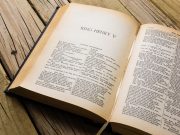Unifying Original Intent and Original Public Meaning
John McGinnis and I have just published a new article on Original Methods Originalism, the interpretive theory that we have developed. In this post, I wanted to describe the first part of the article. In a second post, John will describe the latter part of our piece.
One of the significant challenges for originalism is that it has a division between two interpretive approaches. The two leading approaches are original public meaning (which is a kind of textualism) and original intent (which is a form of intentionalism). Despite years of debate, this disagreement has not gone away.
In the article, we argue that original methods originalism can unify these two interpretive approaches. And therefore, originalists of both approaches—if they apply them correctly—should apply the same interpretive principles.
The Argument for Applying the Original Interpretive Rules
Original methods originalism holds that the Constitution should be interpreted using the same interpretive rules that people at the time would have deemed applicable to the document. Applying those same interpretive rules is the best way of capturing the document’s original meaning. Thus, if the Framers’ generation would have applied certain interpretive rules to the Constitution, so should we.
But following the original interpretive rules also makes sense for the original public meaning and original intent approaches. Under original public meaning, one follows the meaning that a reasonable and knowledgeable person at the time would have employed. A reasonable and knowledgeable person would certainly have applied the interpretive rules that would have been deemed applicable to the document at that time.
While it is less obvious, under the original intent approach one should also follow the interpretive rules that would have been deemed applicable to the document. It is often thought that the original intent approach requires one to follow the meaning that the authors of the document intended the terms to have, not the meaning that would result from applying the interpretive rules at the time. But this is mistaken.
If one asked the authors of the Constitution (or its readers) at the time how to determine the meaning of the document, they would not have answered, look at our intent as to the meaning of the terms. Instead, people at the time would have argued that interpreters should apply the conventional interpretive rules that would have been applied to the document. (John’s post will provide significant evidence for this claim from the debate on the First Bank of the United States.)
There are important reasons why people at the time would not have focused upon the meaning the authors intended as to the provisions of the document. One significant challenge to this practice flows from the difficulty of aggregating differing intents. What does an interpreter do if person A intended one meaning, person B intended a second meaning, and person C intended a third meaning? Applying the conventional interpretive rules avoids this problem. One simply applies those rules, which do not require aggregating intents. Thus, both the original intent and the original public meaning approaches end up applying the same interpretive rules—the ones that would have been deemed applicable to the Constitution at the time.
Determining the Original Interpretive Rules
Another issue the article addresses is how to determine what interpretive rules would have been applied when there was uncertainty or disagreement about the matter. We argue that one should resolve that uncertainty the same way that people at the time would have done so. Significantly, we maintain that people at the time would have employed the common law method to resolve such disagreements and therefore modern interpreters should apply that same method.
Explaining our argument that interpreters at the time would have employed the common law method to resolve disagreements requires a bit of history. During the first three quarters of the 18th century, the principal written laws that governed England and the American Colonies were statutes. In deciding how to interpret those statutes, judges and other interpreters would look to the common law to determine what the statutory interpretive rules were.
When the U.S. declared independence, the new independent states wrote constitutions. Those constitutions needed to be interpreted and in the main the statutory interpretive rules of the common law were applied to them. Constitutions were thus seen as a form of superstatute. Of course, the state constitutions were “statutes” of a certain sort. To the extent that they were less detailed than statutory codes, they would be interpreted using interpretive rules that made sense for shorter, less detailed statutes. Chief Justice Marshall referenced this move in his famous “it is a constitution we are interpreting” line in McCulloch. Significantly, Marshall’s interpretive rule was not a rule that was alien to statutory interpretation. Rather, it was the application of a statutory interpretive rule to a certain type of (superstatutory) enactment.
Thus, when the federal constitution was written, eleven years after Independence, a body of interpretive rules (from statutes and state constitutions) were on hand that were applicable to it. Those were the interpretive rules that should be applied to the Constitution.
It is possible that the interpretive rules that applied to the federal constitution differed in minor ways from the statutory or state constitutional rules. To the extent that the federal constitution was significantly different than statutes or state constitutions, there would be an argument, under the common law method, for treating it differently.
Under the common law, a new type of document, such as a federal constitution, that resembled existing documents would be interpreted by using the existing interpretive rules. If the new document differed from the existing one in a significant way, then the common law might apply a different interpretive rule to it. In the case of the federal constitution, we have not uncovered any important interpretive rules that applied only to the federal constitution (except in the limited sense, as noted above in the McCulloch example, that some interpreters treated the federal constitution as a statute of a particular type).
There is much more to this new article. But the basic point is that the legal interpretive rules are key to discovering the Constitution’s original meaning, under both the original public meaning and the original intent approaches. And those legal interpretive rules are the traditional ones that applied to statutes and state constitutions prior to the enactment of the U.S. Constitution.

